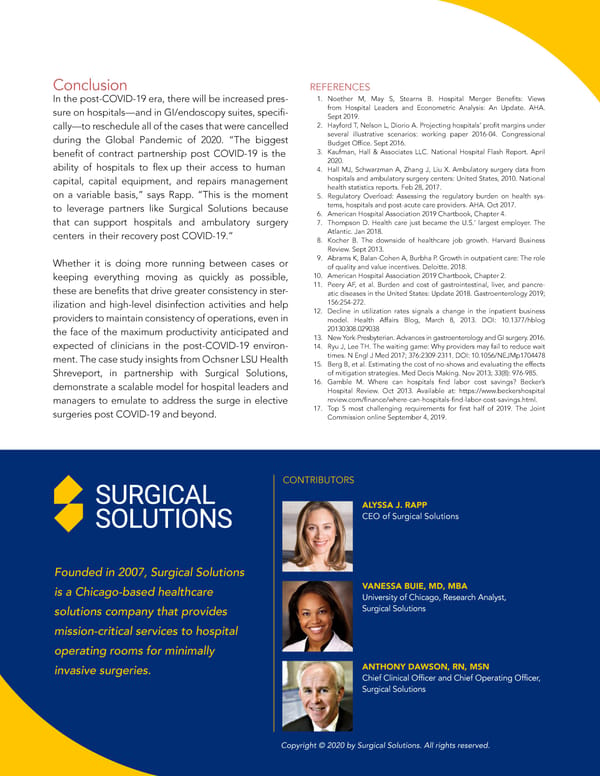Conclusion REFERENCES In the post-COVID-19 era, there will be increased pres- 1. Noether M, May S, Stearns B. Hospital Merger Benefits: Views sure on hospitals—and in GI/endoscopy suites, specifi- from Hospital Leaders and Econometric Analysis: An Update. AHA. Sept 2019. 2. Hayford T, Nelson L, Diorio A. Projecting hospitals’ profit margins under cally—to reschedule all of the cases that were cancelled several illustrative scenarios: working paper 2016-04. Congressional during the Global Pandemic of 2020. “The biggest Budget Office. Sept 2016. 3. Kaufman, Hall & Associates LLC. National Hospital Flash Report. April benefit of contract partnership post COVID-19 is the 2020. ability of hospitals to flex up their access to human 4. Hall MJ, Schwarzman A, Zhang J, Liu X. Ambulatory surgery data from hospitals and ambulatory surgery centers: United States, 2010. National capital, capital equipment, and repairs management health statistics reports. Feb 28, 2017. on a variable basis,” says Rapp. “This is the moment 5. Regulatory Overload: Assessing the regulatory burden on health sys- tems, hospitals and post-acute care providers. AHA. Oct 2017. to leverage partners like Surgical Solutions because 6. American Hospital Association 2019 Chartbook, Chapter 4. that can support hospitals and ambulatory surgery 7. Thompson D. Health care just became the U.S.’ largest employer. The Atlantic. Jan 2018. centers in their recovery post COVID-19.” 8. Kocher B. The downside of healthcare job growth. Harvard Business Review. Sept 2013. 9. Abrams K, Balan-Cohen A, Burbha P. Growth in outpatient care: The role Whether it is doing more running between cases or of quality and value incentives. Deloitte. 2018. 10. American Hospital Association 2019 Chartbook, Chapter 2. keeping everything moving as quickly as possible, these are benefits that drive greater consistency in ster- 11. Peery AF, et al. Burden and cost of gastrointestinal, liver, and pancre- atic diseases in the United States: Update 2018. Gastroenterology 2019; 156:254-272. ilization and high-level disinfection activities and help 12. Decline in utilization rates signals a change in the inpatient business providers to maintain consistency of operations, even in model. Health Affairs Blog, March 8, 2013. DOI: 10.1377/hblog 20130308.029038 the face of the maximum productivity anticipated and 13. New York-Presbyterian. Advances in gastroenterology and GI surgery. 2016. expected of clinicians in the post-COVID-19 environ- 14. Ryu J, Lee TH. The waiting game: Why providers may fail to reduce wait times. N Engl J Med 2017; 376:2309-2311. DOI: 10.1056/NEJMp1704478 ment. The case study insights from Ochsner LSU Health 15. Berg B, et al. Estimating the cost of no-shows and evaluating the effects of mitigation strategies. Med Decis Making. Nov 2013; 33(8): 976-985. Shreveport, in partnership with Surgical Solutions, 16. Gamble M. Where can hospitals find labor cost savings? Becker’s demonstrate a scalable model for hospital leaders and Hospital Review. Oct 2013. Available at: https://www.beckershospital review.com/finance/where-can-hospitals-find-labor-cost-savings.html. managers to emulate to address the surge in elective 17. Top 5 most challenging requirements for first half of 2019. The Joint surgeries post COVID-19 and beyond. Commission online September 4, 2019. CONTRIBUTORS ALYSSA J. RAPP CEO of Surgical Solutions Founded in 2007, Surgical Solutions V is a Chicago-based healthcare ANESSA BUIE, MD, MBA University of Chicago, Research Analyst, solutions company that provides Surgical Solutions mission-critical services to hospital operating rooms for minimally invasive surgeries. ANTHONY DAWSON, RN, MSN Chief Clinical Officer and Chief Operating Officer, Surgical Solutions Copyright © 2020 by Surgical Solutions. All rights reserved.
 Driving Efficiency & Throughput Page 8
Driving Efficiency & Throughput Page 8 